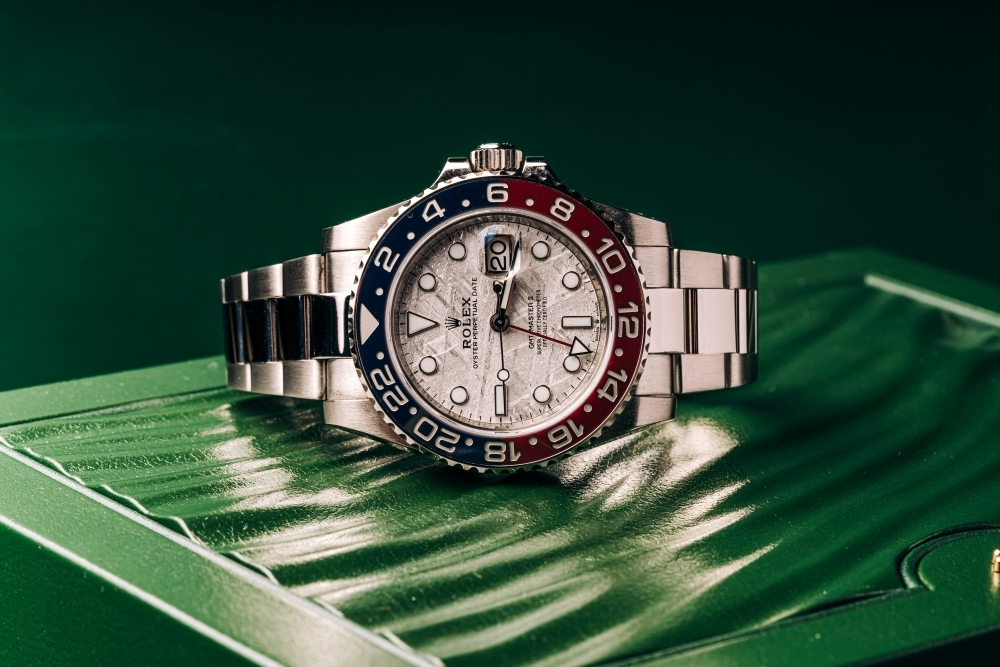A Guide to the Rolex Oyster Perpetual – The Original Rolex
If any single timepiece can claim to be the foundation of Rolex’s legacy, it’s undoubtedly the Oyster Perpetual. Introduced in 1931, this landmark watch unveiled two defining innovations – the first truly waterproof ‘Oyster’ case, and the pioneering self-winding Perpetual movement. Unlike other Rolex models, the Oyster Perpetual wasn’t built for a specific pursuit but for everyday life, guided by a philosophy of reliability and elegant simplicity. While it may not generate the same buzz as Rolex’s sportier pieces, it remains a cornerstone of the brand’s identity – nearly every Rolex today bears the words “Oyster Perpetual” on its dial. In this sense, the Oyster can be viewed as the first Rolex – the origin from which all others descend.

The Oyster Perpetual – A Waterproof, Self-Winding Revolution
The story begins with Hans Wilsdorf – co-founder of Rolex – and his pursuit of a wristwatch that could withstand daily wear in any environment. In 1926, Rolex unveiled the Oyster case – an airtight, waterproof housing that protected the movement from dust, moisture, and shock. A year later, it was put to the test by legendary endurance swimmer Mercedes Gleitze – the first known person to swim the Straits of Gibraltar and the first British woman to swim the English Channel. Gleitze attempted to cross the Channel wearing a gold Rolex Oyster on a ribbon around her neck, and after more than ten hours in frigid seawater, the watch emerged in perfect working order. Rolex capitalised on the success, running full-page newspaper ads proclaiming the Oyster’s reliability. It was a marketing coup, and a highly successful one at that.
In 1931, Rolex introduced the “Perpetual” movement – the first self-winding mechanism powered by a 360-degree rotor that moved with the motion of the wrist. The early Oyster Perpetual models of the 1930s (nicknamed “Bubblebacks” for their rounded casebacks) were modest in appearance but groundbreaking in function, embodying Wilsdorf’s twin ideals of automatic winding and all-weather durability.
Throughout the 1940s and ‘50s, Rolex continued to prove the Oyster Perpetual in extreme conditions. High-altitude pilots, divers, and mountaineers wore them on expeditions around the world – most famously the 1953 British Everest expedition. For the trip, Rolex supplied several members of Sir John Hunt’s team – including Sir Edmund Hillary and Tenzing Norgay – with a number of Oyster Perpetual watches to test in the harsh conditions of high-altitude climbing. The watches performed exceedingly well during the ascent, and the success of the expedition later inspired Rolex to develop and launch the Explorer, which commemorated the achievement and built upon the same Oyster Perpetual foundation.
Read More: Rolex Datejust
The Evolution of the Oyster Perpetual – Notable Examples
Over roughly 90 years, the Oyster Perpetual and its antecedents have appeared in several variations, from gold vintage classics to colourful Oystersteel collectables. Below, we highlight four notable examples that represent the breadth of this model’s storied history, technical evolution, and collector appeal.
Rolex Oyster (1927) – The Mercedes Gleitze Oyster
The watch worn by Mercedes Gleitze during her 1927 Channel swim is the most historically significant Rolex Oyster. Though predating the Perpetual rotor, this elegant 9-carat gold timepiece was the first to prove Rolex’s waterproof case under extreme conditions and cemented the brand’s reputation for engineering. Nearly a century after it braved the English Channel, the piece is set to make history again – this time at auction. Scheduled for sale at Sotheby’s Geneva in November 2025, it’s expected to achieve over $1.3 million, a testament to its mythic status among collectors. While somewhat modest in appearance, the legacy of the Gleitze Oyster is profound: the spiritual starting point for every modern Rolex tool watch.
Read More: Rolex Daytona
Rolex Air-King Reference 5500 – The Pilot’s Oyster Perpetual
Not every Oyster Perpetual carries the name outright, and the Air-King, introduced in 1945, is a perfect example of that. Originally created as a tribute to RAF pilots who had worn Rolex Oysters during the Second World War, the Air-King – now its own line – began its life as part of the Oyster Perpetual family. Early versions featured the same waterproof Oyster case and self-winding movement, often signed “Rolex Oyster Air-King” on the dial. The most iconic iteration, the Reference 5500, borrowed the clean design language of the standard Oyster Perpetual, with a 34mm steel case, simple three-hand dial, and reliable automatic movement. Today, vintage examples are one of the most accessible entries into Rolex collecting, with subtle quirks (like rare red-letter dials) particularly prized among collectors.
Rolex Oyster Perpetual 41 – A Colourful Modern Revival
In 2020, Rolex refreshed the legacy Oyster Perpetual series with a new 41mm case, updated calibre 3230 movement, and – most surprisingly – a playful range of lacquered dials echoing the iconic ‘Stella’ dials of the 1980s Day-Date. Dial colours included candy pink, vivid green, and coral red, but most prized was the ‘Tiffany’ turquoise blue, which traded up to five times its retail price on the secondary market. The range was discontinued in 2023, and it has since become something of a modern classic – proof that Rolex can stick with tradition while embracing colour, creativity, and individuality.
Read More: Rolex Submariner
Rolex Oyster Perpetual 2025 – The Pastel Palette
Building on the success of its 2020 collection, Rolex released a softer follow-up for 2025. The new pastel series introduced muted tones of lavender, mint green, and sandy beige across the full range of Oyster Perpetual case sizes, from 28mm to 41mm – a notably subdued shift from the pop-art colours of 2020. Inside, the watch remains technically unchanged, featuring the same COSC-certified calibre 3230 and robust Oystersteel construction, now paired with a slightly slimmer clasp. Classic and colourful, these pastel variations sit at the more accessible end of the Rolex retail spectrum, with prices starting at AED 23,030.
Final Thoughts
From its 1920s origins to its modern-day revival, the Rolex Oyster Perpetual remains the purest expression of a Rolex: technically robust, reliable, and timelessly elegant. This is the watch that introduced the innovations that came to define the brand, and whether worn on a mountaintop or out to dinner, it rises to the occasion. As recent auctions and experimental dial releases have shown, it remains both collectable and approachable, appealing equally to seasoned collectors and first-time buyers. Nearly a century on, it still distils Rolex into its simplest, most enduring form.



